San Francisco's Hotels as Exemplars
This study draws on a national literature but focuses especially on the hotel history of San Francisco. San Francisco rarely led national trends
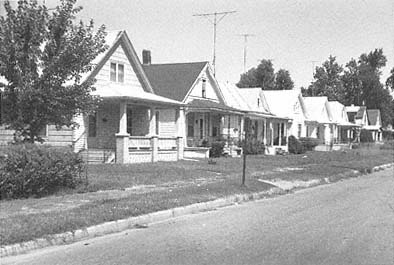
Figure 1.11
Workers' houses near the Santa Fe railroad yards, Topeka, Kansas,
built ca. 1915. New neighborhoods like these stressed the uniformity,
single use, and visually coherent organization of new city rules.
in hotel life; instead, its experience after the Civil War epitomizes experiences repeated, with minor variations, in hundreds of other American cities. What was ordinary in San Francisco proved similar to what was ordinary in Chicago, New York, or St. Louis. Thus, in the chapters that follow, examples from San Francisco will predominate with corroborating asides and illustrations drawn from elsewhere.
A Case Study City
Compared to cities on the East Coast, San Francisco's evolution began late and eccentrically with the gold rush of 1849. From 1849 to 1870, San Francisco was notoriously unlike other cities: it had many more men than women, more Chinese immigrants than anywhere else in the United States, a notoriously unconventional population, and very tenuous transportation links to the East. However, by 1870, San Francisco's manufacturing and downtown office employment was burgeoning; by 1880, its population profile looked roughly similar to that of other large U.S. cities. Some differences remained. Tourism was a greater part of the urban economy than in other American cities. The housing of San Francisco—wooden row houses instead of wooden open-lot houses—was also more like that of the East Coast or older midwestern cities than like other cities of the West or the South. But with those exceptions, San Francisco's industries and housing roughly reflected national patterns. By 1900, San Francisco ranked eighth in the nation for industrial production, and it was also
the predominant wholesaling and financial center for much of the West. The earthquake and fire of 1906 leveled all of downtown but merely hastened the rebuilding of obsolete structures. By 1915, the land uses and buildings of rebuilt San Francisco were not strikingly different from those in cities that had no great fire.[43]
More than was true in any other city, the citizens of San Francisco tested the validity of hotel living. Nineteenth-century tourists noted that "vast numbers" of residents lived in hotels and ate exclusively in restaurants. In both 1880 and 1900, the ratio of boardinghouse and rooming house keepers in proportion to the total population was higher in San Francisco (and other new West Coast cities) than in many of the older American cities.[44] Surely if hotel housing were to have bested its critics anywhere, it would have been in San Francisco. In the late 1950s, Alfred Hitchcock's Vertigo portrayed downtown hotels as natural homes for the city's young secretaries. In the 1970s, some of the most bitter struggles over hotel living—the destruction of hotels in the South of Market and the fight over the International Hotel—showed an unusual public awareness of hotel housing.
While more of a hotel city than other cities, San Francisco was not an anomaly. It was simply the most highly developed example of hotel housing. Because so much of the city's economy and population appeared after 1865 on a relatively empty stage, San Francisco's architectural and social history exhibited national post-Civil War industrialization and trade with little competition from previous eras. Bursts in hotel construction in San Francisco were also matched in other West Coast cities, in the Midwest, and on the East Coast.[45] Based on both written and architectural evidence, San Francisco had about 15,000 hotel rooms of all types in 1880, or about one hotel room for every 16 people in the population. In 1910, those figures had grown to 65,000 total rooms, or one hotel room for every 10 people (table 1, Appendix). That ratio remained roughly the same through 1980.[46]
From the early 1800s up to the 1960s, managers in hotels of all types mixed permanent and transient guests, often with seasonal variations. A 1930 survey of the more expensive American hotels showed that about a third were mainly transient and about a sixth were mainly permanent. Managers of the remainder called their businesses "mixed transient and permanent."[47] The mixture of transient and permanent guests also varied by the type of hotel. It appears that permanent resi-
dents lived in an average of 20 percent of the rooms in the most expensive third of American hotels and at least 75 percent of the rooms in the remaining cheaper hotels.[48] This was likely the case for at least several months of the year (if not year-round) and in most American cities. Applying these ratios to San Francisco indicates that a consistent 60 percent of all of the city's hotel rooms between 1880 and 1930 were permanent residences for at least one or two seasons of the year. This is slightly more than the precise 52 percent reported for San Francisco in 1980, with the city's much expanded tourist industry and reduced use of hotels as residences.[49] A San Francisco sample also revealed four very distinctly stratified sets of building types that are found in most American cities.
Hotel Ranks, Social Class, and the Plan of the Book
The four types of average hotels in San Francisco can be characterized as palace hotels, midpriced hotels, rooming houses, and cheap lodging houses. These four ranks of building types, arrived at strictly by architectural evidence, closely match social stratification suggested in written records. In 1903, for instance, the New York hotel keeper Simeon Ford amused a banquet of hotel managers with this characterization of hotel life:
We have fine hotels for fine people,
good hotels for good people,
plain hotels for plain people,
and some bum hotels for bums.[50]
The original construction details of these four types of hotels—especially their plumbing and air wells—were surprisingly reliable counterparts to the social stratification and class differences of their intended original clients as summarized by Ford. By the end of the nineteenth century, city residents easily recognized the four types of hotels and the social status of their residents (these are discussed in detail in chaps. 2–5).
At the social pinnacle were the buildings of a price range best called the palace hotel rank (fig. 1.12). Like Cyril Magnin, the people who lived in such hotels were generally from the nation's wealthiest families. When people at this rarified social and economic level chose their homes, cost mattered little. Their hotel suite was often one of several
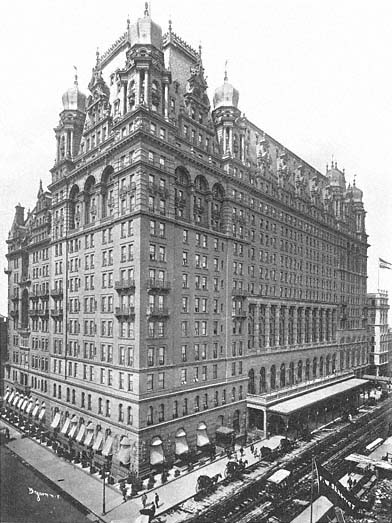
Figure 1.12
The original Waldorf-Astoria, a quintessential palace hotel. In 1907, it
became the largest hotel in the world when the Astoria section was added
to the 1893 Waldorf.
residences. If they lived in an apartment, it was also palatial; if they had a house, it could be a mansion or an estate.
Hotels of the next cheaper type, the midpriced hotel rank , were intended for overnight guests and permanent residents who had a comfortable income and intermediate social status (fig. 1.1). In their basic values, politics, museum or church activities, education, and recreation, these people often emulated the truly wealthy. With their best clothes and manners they could infiltrate the palace hotel dining room for a memorable meal, but they could not live like that every day. Their incomes forced compromise, but as chapter 3 shows, it was socially respectable compromise. If they had not lived in a hotel, they might
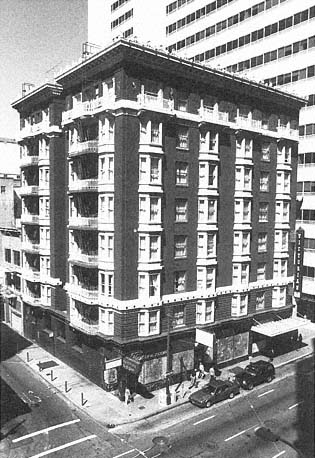
Figure 1.13
Typical midpriced hotel, built in 1914.
have chosen a substantial private house or flat with one to three servants or an apartment hotel.
Americans informally called these two social strata the upper class and the middle class. However, between these two groups there was little of the social or cultural opposition that theorists require for a true division between classes.[51] The palace and midpriced hotel groups were two levels within a single class; they were the "middle and upper class," with "class" in the singular. The material culture evidence of their hotel housing, like other social and cultural indicators, showed that their differences were matters of degree rather than proof of sharply divergent and opposing realms. For people in the middle and upper class, hotel life was a choice; they could afford to live in other ways and encountered few barriers in doing so. However, the people in the middle and upper class were in clear cultural and often political opposition to the
residents of the two less expensive hotel types, whose residents had much less choice in housing. In their work, ownership of property, and access to cultural and economic power, the people of the upper two hotel ranks differed markedly from those of the two lower hotel ranks. Here was a true class division with both cultural and economic formations. Their material culture was an important reinforcement—not merely a reflection—of position and power. Both sides displayed in their material life a decided class consciousness, as was particularly clear with rooming house residents.
Ford called the rooming house rank of hotels "plain hotels for plain people." Such places were home for people in skilled trades who earned a steady but relatively low income, especially before the 1930s. For the single teacher, stenographer, and machinist, their rooms, their financial instability, and often their personal lives were evidence of the sharp division that stood between them and the upper and middle class. However, chapter 4 shows that rooming house residents relied on their rooms for a minimum of material respectability, a tool to mask their differences from the middle and upper class. If roomers wished to live outside of a family or live alone, they had few other affordable housing choices. Roomers also had the choice of boarding or lodging with a family, with the consequence of again living under household surveillance.
Finally, at the cheap lodging house rank , hoboes and day laborers hung precariously on to shelter with the marginal incomes they obtained when work was available. While the cultural opposition of rooming house residents was subtle, lodging house residents lived and worked in flagrant opposition to the rules of the middle and upper class. The lodging house residents' poverty, backgrounds, political beliefs, family life, speech, and education all set them utterly apart from the polite society of the middle and upper class. If they wished to live in the city, lodging house residents had virtually no other choice but to live in some version of a cheap downtown hotel (fig. 1.14).
The cultural and social opposition of rooming houses and cheap lodging houses to middle and upper class norms did the most to bring official condemnation on hotel housing of all four ranks. The first half of this work analyzes hotel life and downtown cosmopolitanism as valuable public resources, while the second half traces the idea of hotel life as a public nuisance. Chapter 6 examines the segmentation of hotel
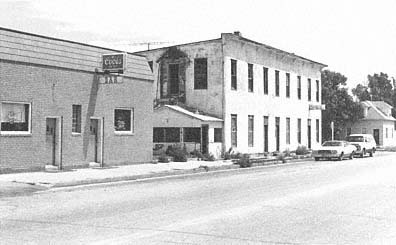
Figure 1.14
Workers' hotel in Mineral Wells, Colorado, 1985. Residential hotels
have been common in small towns as well as in large cities.
This small lodging house apparently closed about 1970.
owners and how their increasing specialization of the city intensified downtown as a zone of residential opposition. Chapter 7 looks in detail at the critiques of hotel life and the gradual ways that residential hotels became defined as an aberration. The last two chapters follow the expert reformers of the Progressive Era and the post-World War II period as they worked to build the long-desired new city and to eliminate hotels and cosmopolitan diversity. No matter what position one takes on hotels as homes, their rapidly dwindling inventory cannot be seen simply as an accident of supply and demand in a free market. The crisis in the residential hotel supply is a planned event—a function of local, state, and federal government policies that have encouraged housing for some types of people and reduced supplies of housing for others.[52]
The mistrust of cheaper hotels is more understandable in light of their historical dominance in downtown hotel life (fig. 1.15). The residential proportion of hotels was heavily weighted toward the inexpensive hotel types. Indeed, the architectural evidence in San Francisco reveals that cheap lodging-house rooms made up half of the city's hotel homes. Rooming houses provided a third of the residential hotel rooms. Rooms likely to be used as permanent residences in palace and midpriced hotels, combined, made up only the remaining sixth of the residential hotel stock. These proportions remained roughly the same between 1880 and 1930 (table 1, Appendix).[53]
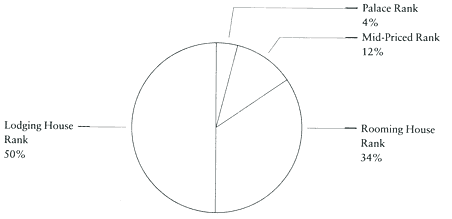
Figure 1.15
Proportional diagram of residential hotel rooms, by rank, in San Francisco in 1930.
Surveys in 1880 and 1910 revealed similar distributions.
The issues of hotel life still reverberate in the lives of recent hotel residents—from Cyril Magnin in his palace hotel and Dorothy Johnson in her midpriced hotel to people like Jane Wagner in rooming houses and the Filipino laborer Felix Ayson in his cheap lodging house. The history of hotel living shows the dangers of too rigidly enforcing a single ideal for the American home. Nonetheless, the people who felt most immune from the criticism of hotels were those in palace hotels. More than any other types of hotel residents, they had all the advantages of living downtown.